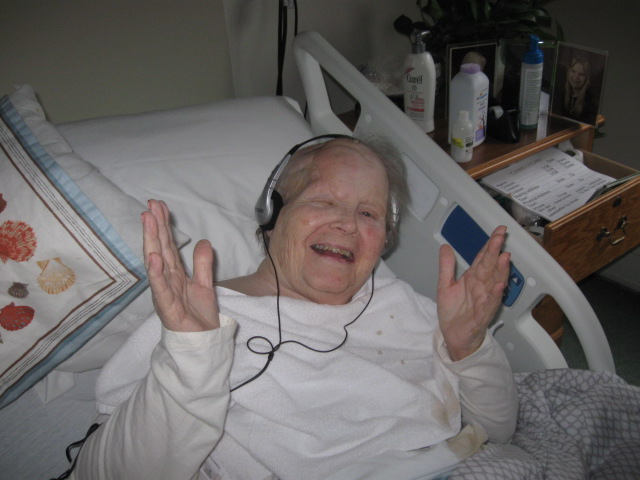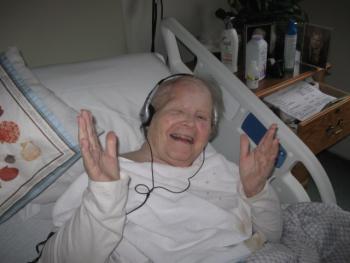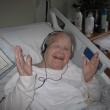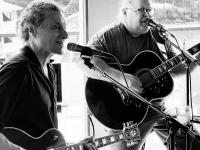Music therapy brightens patients’ lives
Nancy, a resident at St. Andrews Village Gregory Wing, has a volunteer place headphones over her ears and press play on her iPod shuffle. Nancy’s iPod is filled with songs by The Carpenters, Peter, Paul and Mary and Simon & Garfunkel to name a few. Nancy’s smile beams and her eyes brighten as she listens. Nancy is one of over a dozen residents in the Boothbay Harbor facility benefiting from a new therapy: Music & Memory. According to Gregory Wing Activities Program Manager Jerie Phinney, the program has resulted in remarkable changes in managing pain, anxiety, depression and agitation.
The therapy was first developed in 2010 for residents dealing with more progressive forms of memory loss: Alzheimer’s disease and dementia. The therapy has done wonders for other residents, too. Music & Memory uses a personalized iPod playlist to trigger positive responses and memories in residents. In November of 2015, the Gregory Wing staff began providing music therapy to residents suffering from various ailments.
“It’s all about the harmony for Nancy,” Phinney said. “Music that is specific and personal to a resident can trigger a response in the brain, evoking memories of a special time in their lives, bringing happy thoughts and energizing their spirits.” This past winter Nancy added Christmas music and a performance by her daughter to the playlist. She told Phinney that the music brings her great comfort. “Nancy told me last week the music makes her feel at home. When you haven’t lived at home for a while that is quite an accomplishment.”
The Gregory Wing became aware of the program after viewing a 2012 documentary, “Alive Inside,” which showed the amazing transformation in dementia residents by listening to personalized music. The therapy was developed by New York social worker Dan Cole. One day, he introduced music to residents at a nursing home where he was working as a volunteer and it accelerated from there.
As dementia and Alzheimer’s disease progresses, patients can lose their memory, feel disconnected to their surroundings, and often ask, ‘Who am I,’ according to Cohen. The music triggers an emotional response which makes them more communicative, according to Cohen’s initial finding.
Once the focus of the iPod playlist became personalized, residents’ reactions were even more “amazing and immediate,” according to the documentary. Henry was one of several residents featured in the documentary. He typically sat alone, didn’t say much, and only responded to yes or no questions. That was until he heard his own music. Henry then became more engaged and articulate in conversations.
“I started the experiment and an amazing thing happened,” Cohen said in the documentary. “Patients who hadn’t spoken for years became communicative. Another non-communicative patient began singing, and one wheelchair-bound patient got up and tried to salsa.”
This led Cohen to start “Music & Memory,” a non-profit organization that brings personalized music into the lives of the elderly or infirmed through digital music technology. According to Cohen and Phinney, it has vastly improved residents’ quality of life.
Cohen discovered that none of the 16,000-plus nursing home facilities in the U.S. and Canada used music therapy for treatment. In 2010, Cohen established Music & Memory to provide training for those facilities to integrate the therapy into their programs.
In the fall of 2015, seven people locally — three employees, two volunteers, a Boothbay Region High School music teacher and student --- became Music & Memory certified to help residents in the Gregory Wing.
The new program requires an iPod shuffle, headphones, music, fundraising activities for purchasing iTunes gift cards and iPod shuffles, and volunteers capable of performing extensive interviews to discover music which elicits emotional resident responses.
East Boothbay resident Holly Fulmer is one of the Gregory Wing volunteers. She is tasked with finding music with the most emotional impact on the patients. Fulmer observes the patient for a positive comment while they connect with a particular song.
“It’s a time-consuming, but rewarding process,” Fulmer said. “A reaction that is just okay or fine is not acceptable. I’m looking for a thumbs up, smile or spontaneous singing.”
The vast majority of residents using this program in the past several months responded positively to their personal music.
“It’s not just music, it’s the right music,” Phinney said. “Music from when they were in their late teens and early twenties often provides the biggest impact on them.”
According to Phinney, Gregory Wing residents show tremendous improvement when they start listening to their personal music. Residents ranging in age from their 60s to 100 have benefited from the program.
Earle, a former church deacon, was often confused and unable to make his feelings known. He began listening to music 30 minutes prior to church and suddenly became bright and attentive.
“Once he started listening to music, he would chuckle and gladly participate in the service, even taking Communion.” Phinney said.
Another resident, John, hadn’t ventured out of his room in the daytime for months. He spent his days in his room with the shades drawn watching television. His daughter mentioned he liked Johnny Cash. Fulmer created a Johnny Cash iPod playlist and gave it to John.
“Instead of wearing his typical T-shirt and jeans, he dressed up in his plaid shirt and put on a cowboy hat and started walking the halls,” Phinney said. “He became more social and his speech was clearer. He had light in his eyes and a lift in his step!" John conveyed his interest in other country and western recording stars. He couldn’t remember one singer’s name, but recalled that he had died in a plane crash. Fulmer searched the Internet and found the artist, then searched iTunes for his music.
“It turned out to be Jud Strunk. The song on iTunes was one he had dedicated to John during a concert. “The music carried a special meaning for him and brought back special memories,” she said.
The Gregory Wing is looking for volunteer participation in the project. BRHS music teacher Mary Miller was one of the original seven who took the specialized training. She became a certified participant and plans on recruiting her students as project volunteers.
“I’m a music person and I know how important music is to the soul. I know it’s already making a difference in the Gregory Wing’s residents’ lives,” Miller said. “I will help with fundraising and I’m trying to acquire more iPod shuffles. I hope to become more involved in this project.”
Residents are given an iPod shuffle loaded with their individual music, headphones and a charger at no cost to them. The cost to the facility is about $80 per resident. Phinney plans on offering more certification training for staff and volunteers in the future, but the focus is now on recruiting and fundraising.
The Music & Memory program is still in its infancy but has already had significant and positive impact. Long-term care professionals in Boothbay Harbor and around the U.S. have only just begun to use this technology as a tool for managing pain, agitation, depression, and anxiety in long term care residents.
Event Date
Address
United States



























